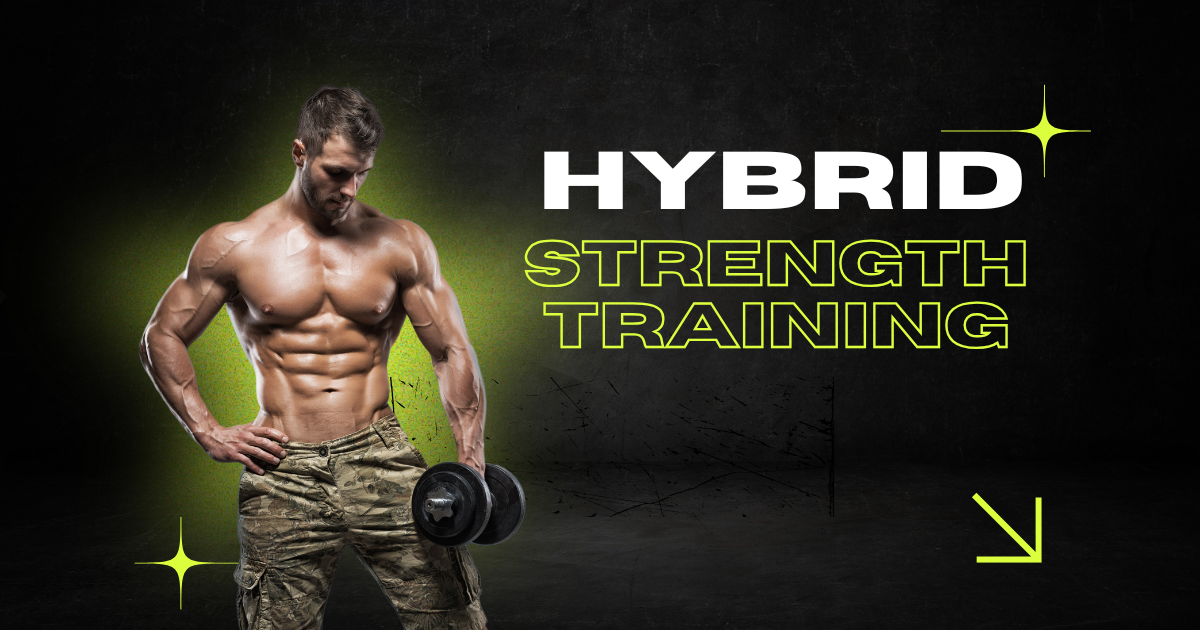1. Introduction
Hybrid strength training is a new breed of fitness that combines strength training and endurance workouts in one program. This training style provides muscle gains and develops cardiovascular fitness, making it ideal for a person looking for a complete workout routine. In this article, we’ll explore the benefits of hybrid strength training, including some workouts and tips for getting started.
2. What Is Hybrid Strength Training?
Hybrid strength training is a fitness method that combines traditional weightlifting with endurance exercises, like running, cycling, or high-intensity interval training (HIIT). Hybrid training is a comprehensive approach that develops both your muscular and cardiovascular fitness—quite unlike programs specializing in strength or cardio. Focusing on these elements has added to overall athleticism and functional ability in life.
3. Benefits of Hybrid Strength Training
- Improves Overall Fitness: It yokes strength with endurance; both lead to a balanced physique.
- Builds Muscle and Burns Fat: Do workouts that help you build strength and burn calories at the same time.
- Increases Cardiovascular Endurance: Cardio, part of your routine, builds your heart and lungs.
- Saves Time: You can accomplish multiple fitness objectives in a workout session.
- Supports Diverse Goals: Hybrid training is versatile if you’re training for a marathon or working toward body recomposition.
4. Who Should Try Hybrid Strength Training?
Hybrid strength training is suitable for the following:
- Athletes: Improve your strength and stamina for performance.
- Fitness Enthusiasts: Diversify workout routines to avoid plateaus.
- Beginners: Build a strong foundation in both strength and endurance.
- Time-Conscious Individuals: Get more done in less time with a comprehensive approach.
Consider consulting a trainer if you have pre-existing injuries or health concerns.
5. Key Components of a Hybrid Strength Training Program
- Strength Training: Concentrate on complex lifts such as squats, deadlifts, and bench presses.
- Cardio Integration: Add in some running, rowing, or cycling for extra endurance.
- Intensity Balance: To avoid burnout, alternate high- and moderate-intensity sessions.
- Recovery: Prioritize rest days and active recovery to allow your body to adapt.
- Weekly Schedule Example:
- Monday: Strength training (upper body) and light cardio (15 minutes)
- Tuesday: HIIT session (20-30 minutes)
- Wednesday: Rest or active recovery (yoga, stretching)
- Thursday: Strength training (lower body) + moderate cardio (30 minutes)
- Friday: Hybrid circuit workout (full body)
- Saturday: Long endurance session (running or cycling)
- Sunday: Rest
6. Best Hybrid Strength Training Workouts
- Full-Body Circuit Training: Combine exercises like kettlebell swings, push-ups, and burpees for a dynamic session.
- Strength Training with Cardio Finishers: End weightlifting sessions with a short, intense cardio burst (e.g., sprints).
- CrossFit-Inspired Workouts: Perform WODs (Workouts of the Day) that mix weightlifting and bodyweight exercises.
- Interval Running with Weighted Exercises: Alternate between running and exercises like lunges or pull-ups.
- Sample Workout:
- Deadlifts: 3 sets of 8 reps
- Push-Ups: 3 sets of 15 reps
- Rowing: 500 meters (3 times)
- Burpees: 3 sets of 10 reps
7. Tips for Success in Hybrid Strength Training
- Start Slow: To avoid injuries, start slowly and increase the intensity gradually.
- Focus on Form: Effectiveness and safety depend on proper technique.
- Track Progress: Write down or use an app to keep track of your strength and fitness gains.
- Eat for Recovery: A balanced diet is important, including protein, carbs, and healthy fats.
- Prioritize Recovery: Get enough sleep and include rest days in your routine.
8. Common Mistakes to Avoid
- Overtraining: Too much intensity without rest can lead to burnout or injury.
- Neglecting Recovery: Skipping rest days hinders muscle repair and growth.
- Imbalanced Workouts: Overemphasis on strength or cardio disrupts the hybrid approach.
- Skipping Warm-Ups and Cool-Downs: Always prepare your body for exercise and aid recovery afterward.
In order to avoid these situations, feel your body and adjust training accordingly. So, once again, this truly is an individual approach that may be best refined with the guidance of a fitness professional for the most effective results for you!
9. How to Get Started with Hybrid Strength Training
- Assess Your Fitness Level: Concentrate on your strengths and weaknesses. Knowing your physical status will better allow you to create a plan that meets your abilities and goals.
- Set Clear Goals: Identify the goal you want to achieve (muscle gain, endurance improvement, weight loss, etc.). Having clear goals will maintain motivation and monitor progress in the long run.
- Choose the Right Equipment: They can start with simple equipment such as dumbbells, resistance bands, and a cardio machine. Once you become more adept, you can add more technical tools to push you.
- Find a Plan: Stick to a well-defined routine or consult a professional coach. A solid plan balances development in terms of strength and endurance.
- Stay Consistent: For hybrid training to be part of your weekly routine, Long-term results can only come when you are consistent and will be able to achieve your fitness goals.
11. Conclusion
Strength training is a great approach to simultaneously increasing strength and endurance; hybrid strength entails balancing the two training modalities to raise your level of general fitness. Everyone from athletes to weekend warriors to novices can realize their goals faster with this approach. Just start small, make it consistent, and reap the benefits of this dynamic training method. Have questions? Let us know in the comments below!
10. FAQs About Hybrid Strength Training
What is the difference between hybrid strength training and CrossFit?
The goal of hybrid strength training is to balance and organize traditional strength and endurance training. Contrarily, CrossFit involves a variety of functional motions done at a high level of intensity, frequently in a competitive group environment. Although strength and endurance are combined in both methods, hybrid training is less intensity-driven than CrossFit and gives greater flexibility.
Can beginners do hybrid strength training?
Yes, novices may also begin hybrid strength training utilizing lighter weights and low-intensity cardiovascular workouts. Move onto the next step as you get fitter. Training progresses best when a plan is followed, or a trainer is engaged to avoid injury and learn proper technique.
How often should I do hybrid strength training?
Sessions 2-5 per week are generally enough for best results. Incorporate variety within your weekly routine by having strength days, cardio days, and rest days to recover and prevent overtraining.
What equipment do I need for hybrid strength training?
All you need to get started is a few basic pieces of equipment (For example, resistance bands, dumbbells, kettlebells, and a cardio machine such as a rowing machine or treadmill). If you don’t have a workout gateway like a gym, you can always use bodyweight exercises for strength training.
Can I build muscle with hybrid strength training?
Yes, hybrid strength training can help you gain muscle, particularly if you emphasize progressive loading and eat a sufficient amount of protein-rich food. Strength and muscular tone are enhanced when resistance training and endurance workouts are combined.
Is hybrid strength training good for weight loss?
Absolutely! Hybrid training, which combines strength and cardio, burns calories while maintaining lean muscle mass, making it efficient for long-term weight loss.
How do I balance cardio and strength in hybrid training?
Pick your strength days versus your cardio days, or incorporate both in a single workout (like strength training followed by a short cardio burst). If your goal is to build muscle or improve endurance or other areas of fitness, adjust the intensity and length accordingly.
Are there any risks involved in hybrid strength training?
The main risks are overtraining, bad form, and not getting enough rest. These things can hurt you or slow you down. To keep risks to a minimum, make sure you use the right form, start at the right level of intensity, and give yourself enough time to rest between practices.





